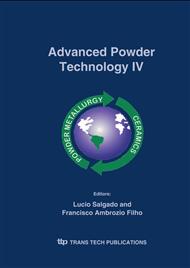p.258
p.264
p.270
p.278
p.285
p.293
p.299
p.305
p.311
The Nitriding of Ferrous Powder Alloys - Mathematical Modelling and Simulation
Abstract:
Mathematical modelling has been developed to improve processes control and has helped theories about complex systems to be written. Nitriding is a multivariable system that needs the convergence of efforts to allow its improvement. Computer simulation is an important tool to give a simultaneous evaluation of all variables and respective effects in the result of the process. Surface conditions have an important effect in the interaction between gases and metals. Its influence can only be studied under two-dimensional and 3-D simulations. The presence of oxides and other barrier have a critical influence on the kinetic and on the result of the process. Secondary reactions such as precipitation and nitride layer formation also affect the process. Particularly, porosities can have an important effect by enhancing the gas permeation inside the sintered material. Depending on the variables that might be deleterious to the process, the simulations give some indications how to proceed and how to control these process variables. This work show, through simulation tools, how variables such as gas atmosphere, temperature, powder surface conditions, porosity and alloy composition will affect the final result of the nitriding process of sintered and non-sintered powders. A methodology was developed using numerical methods and systemic algorithms.
Info:
Periodical:
Pages:
285-292
Citation:
Online since:
November 2005
Authors:
Keywords:
Price:
Сopyright:
© 2005 Trans Tech Publications Ltd. All Rights Reserved
Share:
Citation:


